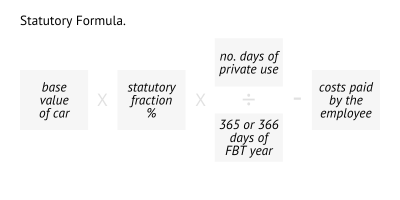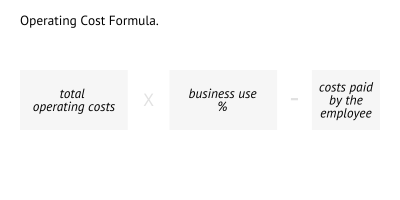What is a car fringe benefit?
A car fringe benefit commonly arises when an employer makes a car they own or lease available for the private use of an employee. If you conduct your business through a company or trust, you may be an employee of the company or a trust.
A car is made available for private use by an employee on any day the car:
- is used for private purposes by the employee or associate; or
- is not at your premises, and the employee is permitted to use it for private purposes; or
- is garaged at their place of residence, regardless of whether they have permission to use it privately.
You can calculate the taxable value of a car fringe benefit using either the statutory formula method or operating cost method.
Statutory formula method
The taxable value is calculated by applying a statutory formula percentage to the base value cost of the car at the date of purchase or lease.
Your liability is reduced by the number of days the car was not available for private use, and any employee contributions made towards the running and maintenance costs of the car from their after-tax salary (commonly known as unreimbursed car expenses).

Base Value. If you’ve owned the car for less than 4 years when the FBT year began, the base value is the original cost price of the car, or ⅔ of the cost price if owned for more than 4 full years. A car first owned prior to 1 April 2018 (and on or after 1 April 2017) will be eligible to the 2/3 base value.
Cost price. The original purchase price including GST and luxury car tax but excluding, stamp duty, registration, acquisition costs such as delivery and non-business accessories like paint, fabric and rust protection or window tinting.
Statutory Fractions. From 1 April 2014, there’s been a flat rate of 20% applied regardless of how many km’s were travelled in the FBT year, except where there is a pre-existing commitment in place before 7:30pm, 10 May 2011.
Operating cost method
The taxable value is based on the private usage proportion of the total costs of either owing or leasing and operating a car during the FBT year less any employee contributions.

Operating costs. Includes actual costs such as running costs (repairs, maintenance, fuel, registration and insurance), charging costs for EV’s and:
- deemed costs such as depreciation and interest if the car is owned; or
- leasing costs if the car is leased.
For cars owned by the employer, deemed depreciation is calculated by multiplying the depreciated value of the car at the start of the FBT year by the deemed depreciation rate applied at the time the car was purchased. Deemed interest is calculated by multiplying the depreciation value of the car by the statutory FBT benchmark interest rate of 7.77% for 2024.
Logbooks. A logbook must be maintained for a continuous 12-week period to represent the use for the full FBT year and to determine the applicable business percentage of a car. Each logbook you keep is valid for five years, but you are required to start a new logbook at any time if the pattern of use has changed more than 10%.
Private use. Generally, any use of the car that is not for income-producing purposes such as travel to and from work is normally private use, even where the employee undertakes minor errands like collecting the mail.
Employee contribution. Any unreimbursed car expenses incurred, or after-tax contribution made by the employee can reduce the taxable value of a car fringe benefit under the operating cost method, as illustrated.
Exempt car benefits
Work related travel in commercial cars
A motor vehicle benefit will be exempt where the vehicle is a taxi, panel van, utility or other road vehicle designed to carry a load, other than passengers of less than one tonne, and the employee’s private use is limited to incidental or minor. The benefit of these vehicles is that travel between home and work is considered work-related.
Cars used for emergency services
Cars used for emergency services which are garaged or kept at or near an employee’s residence are exempt car benefits, where the car used is a police, ambulance or firefighting services vehicle; is fitted with flashing warning lights and a siren and has exterior markings which indicate its use.
Cars supplied by personal entities
A personal service entity is unable to deduct car expenses from more than one car used by an individual. The second car benefits are exempt in relation to an FBT year. * (S8(4) FTBAA and S86-70 ITAA)
Further help:
The ATO has signalled that there will be an increased focus on FBT this year. Given the ever-improving tools at the ATO’s disposal, in conjunction with the government’s need to raise additional revenues, it is important that employers ensure they remain compliant with their FBT requirements. If you would like to ensure your business is compliant, please contact us. With our expert help, you’ll have peace of mind that you are ticking all the right boxes.
You can find out more about working with Marsh & Partners here. As your Absolute.Account.Ability partner we’re on a mission to make your business life better. We’ll help you set goals for your business, devise an Action Plan to make them happen and meet with you regularly to ensure you stay on track.
Share this article on LinkedIn:
GENERAL ADVICE WARNING: This article is general information only and doesn’t constitute specific advice for your business.







